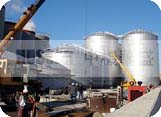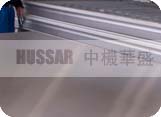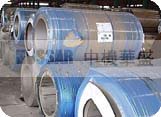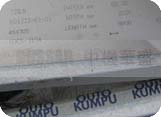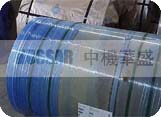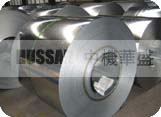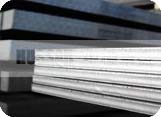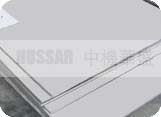| Alloy 800 (UNS N08800),
Alloy 800H (UNS N08810), and Alloy 800HT (UNS N08811)
Alloy 800
(UNS N08800), Alloy 800H (UNS N08810), and Alloy 800HT (UNS N08811) are nickel-iron-chromium
alloys designed to resist oxidation and carburization at elevated temperatures.
The nickel content, 32%, makes the alloys highly resistant both to chloride stress-corrosion
cracking and to embrittlement from precipitation of sigma phase. The general corrosion
resistance is excellent. In the solution annealed condition, Alloys 800H and 800HT
have superior creep and stress rupture properties.
----------------------------------------------------------------- General
Properties
Alloy 800 (UNS N08800), Alloy 800H (UNS N08810), and Alloy
800HT (UNS N08811) are nickel-iron-chromium alloys designed to resist oxidation
and carburization at elevated temperatures. The nickel content, 32%, makes the
alloys highly resistant both to chloride stress-corrosion cracking and to embrittlement
from precipitation of sigma phase. The general corrosion resistance is excellent.
In the solution annealed condition, Alloys 800H and 800HT have superior creep
and stress rupture properties. All three versions of the basic Alloy 800 have
been approved as materials of construction under ASME Boiler and Pressure Valve
Code, Section I-Power Boilers, Section III-Nuclear Vessels, and Section VIII-Unfired
Pressure Vessels. Alloy 800, Alloy
800H and Alloy 800HT are identical except for the higher level of carbon (0.05
to 0.10 percent) in Alloy 800H, and the addition of up to 1.00 percent aluminum
+ titanium in Alloy 800HT. Alloy 800 is normally used in this service at temperatures
to approximately 1100F (593C). Alloy 800H and Alloy 800HT are normally used above
approximately 1100F where resistance to creep and rupture is required. ----------------------------------------------------------------- Applications
Chemical
and petrochemical processing equipment
Power generation
Thermal processing
fixtures
Steel production ----------------------------------------------------------------- Standards
ASTM........... B 409
ASME.......... SB 409
AMS ........... 5871 ----------------------------------------------------------------- Corrosion
Resistance
The chromium and nickel contents of Alloys 800, 800H and 800HT
are higher than those of the familiar Alloy 304 stainless steel alloy. Under many
conditions of service, the performance of Alloys 800, 800H, 800HT and Alloy 304
are similar. For example, comparable behavior can be expected in most rural and
industrial atmospheres and in chemical media such as nitric acid and organic acids.
Neither Alloys 800, 800H and 800HT nor Alloy 304 are suggested for sulfuric acid
service except at lower concentrations and temperatures. Like the austenitic stainless
steels, Alloys 800, 800H and 800HT are subject to sensitization (precipitation
of chromium carbides at grain boundaries) if heated for excessive time in the
1000-1400F (538-760C) temperature range. The sensitized metal may be subject
to intergranular attack by certain corrosive agents including pickling acids or
the boiling 65% nitric acids (Huey) test.
Alloy
800 is highly resistant, although not totally immune, to stress-corrosion cracking.
In extensive field experience, Alloy 800 has shown excellent service performance
in many types of equipment in the petroleum, chemical, food, and pulp and paper
industries. Thus, Alloy 800 may offer a distinct advantage for use in moderately
corrosive environments where service experience has indicated a tendency toward
stress corrosion cracking of other austenitic stainless steels. However, the alloy
is not immune to stress corrosion cracking as judged by the extremely severe magnesium
chloride test. ----------------------------------------------------------------- Chemical
Analysis
Typical Analysis (Weight %)
C Mn P S Si Cr Ni Ti Al Ti + Al Cu
Alloy 800 0.02 1.00 0.020 0.010 0.35 21.0
32.0 0.40 0.40 - 0.30
Alloy 800H 0.08 1.00 0.020 0.010 0.35 21.0 32.0 0.40
0.40 - 0.30
Alloy 800HT 0.08 1.00 0.020 0.010 0.35 21.0 32.0 - - 1.00 0.30
----------------------------------------------------------------- Mechanical
Properties
Typical room temperature mechanical properties of Alloys 800,
800H, and 800HT are shown. Alloy 800 was annealed at 1800F (928C), and Alloys
800H and 800HT were annealed at 2100F (1149C). The different anneal temperature
used contributed to the difference in strength of the materials.
Short Time
Elevated Temperature Properties
The above tables illustrate the short time
high temperature tensile properties of Alloys 800, 800H, and 800HT. The strength
of Alloys 800H and 800HT is lower because the heat treatment of Alloys 800H and
800HT at 2100F (1149C) results in a larger grain size to provide better creep
and stress rupture resistance. The 1800F (982C) anneal of Alloy 800 results in
a finer grain size to provide better cold formability. -----------------------------------------------------------------
Oxidation Resistance
The alloys are particularly well suited for high
temperature applications such as furnace parts and related heating equipment,
for petrochemical reforming units and isocracker tubs, and for handling superheated
steam in nuclear and conventional power plants. With the specified high levels
of chromium and nickel, the alloys offer superior resistance to oxidation and
scaling, and to carburization as well. The
following oxidation data for Alloy 800 was obtained by exposing samples to the
indicated temperature for 100 hours in still air and cooling. In general, total
weight gains greater than 10mg/cm2 indicate that additional exposure at these
temperatures will lead to failure. Since
oxidation rates are greatly affected by heating and cooling rates as well as by
the atmospheres involved, this data can only be used as approximate guidelines.
----------------------------------------------------------------- Heat
Treatment
The anneal cycle conducted on Alloy 800 is typically in the
1800-1900F (982-1038C) range. The purpose is to soften the material after forming
operations while maintaining a relatively fine grain size. The
heat treatment conducted on Alloys 800H and 800HT is typically in the range of
2050-2150F (1121-1177C). In addition to softening the material after forming
operations, an additional purpose of this heat treatment is the development of
larger grains for improved resistance to creep and stress rupture. ----------------------------------------------------------------- Cold
Formability
Alloys 800, 800H, and 800HT exhibit excellent cold forming
characteristics normally associated with chromium-nickel stainless steels. The
high nickel content prevents the austenite to martensite transformation which
can occur when Alloy 301 or Alloy 304 are cold worked. The alloy has a lower work
hardening rate than Alloys 301 or 304 and can be used in multiple drawn forming
operations where relatively large amounts of deformations occur between anneals. As
a consequence of the anneal cycle used on Alloys 800H and 800HT, the large grain
size produces a visibly undulated surface called orange peel after forming.
----------------------------------------------------------------- Welding
Alloys 800, 800H, and 800HT can be joined by tungsten arc (GTAW), gas
consumable electrode (MIG), or by stick electrode welding techniques commonly
used on stainless steels. A number of welding rods and wires are commercially
available for joining the alloys. Since these alloys form tightly adhering scales,
which can be removed only by grinding, inert gas shielding is desirable. | 
